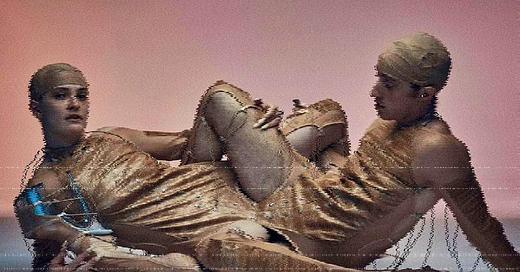
This is a guest post by Aimee Walleston, a writer and cultural critic based in NYC.
There’s something fairly otherworldly about strolling through Chelsea on a summer afternoon, passing other sweating bodies and emporiums designed to tempt –bars, ice cream parlors, sex shops – and entering a large building, taking an elevator three floors up, and walking into a room where two people may or may not be fucking right in front of you.
Vincent Tiley’s three-hour durational performance Silverfish marked the closing of Flesh Becomes Stone, a two-person exhibition with fellow artist Jerry “The Marble Faun” (an extraordinary creator and individual – just read his Wikipedia entry) held at Situations & New Discretions.
Described in the press release as akin to a “Cronenberg sit-in,” the event featured two performers wearing an elaborate, mohawked costume that joins at the crotch. As I watched them perform by alternately switching positions and finding different ways to embrace (while also negotiating lucite stripper heels), I thought about several things: the kama sutra and the meaning behind differing sexual postions; the “tie” phase of dog mating (“a natural phenomenon of dog breeding in which the bulbus glandis of the male's penis swells inside the bitch’s vagina... lock[ing the dogs] together for 15 to 20 minutes”); and the cloacal sac found in frogs and other species.
One of Tiley’s ”rope paintings” featured in this presentation, How Bats Drink Water (2019), hints that my thoughts around animal behavior (human and otherwise) might not be so far off the mark. Made from silk chiffon bound with rope and painted with crackling layers of black tempera, the work is of a piece with Tiley’s ongoing interest in both representing and transcending the human body. As the artist explained in an interview with Zeit Contemporary art, the rope paintings “...came out of an idea about how to convey some of the ideas from my performances in a form that doesn't require performers... I wanted to create a painting style that had or that could convey this idea of an embodied presence in a room–that you weren't looking so much at a painterly surface or an object, but you got a sense that you were looking at an actual body...”
Paired with actual live bodies – as well as The Marble Faun’s frozen phantasms–the works in the gallery seem to blur the line not only between corporeal and material, but also the distinction between human beings and the apparel that we adorn. Whether we have the consciousness to accept this or not, our garments continuingly signal to the world our implicit and explicit sexual desires–or lack thereof (which, as psychoanalyst Jacques Lacan has commented, is also a desire in and of itself). As Tiley has remarked, in relation to the artist’s fashion work: “I have a hard time believing that a person stops at the edge of their skin”. The boundaries we construct around our sexual identities are as rigid or as pliable as we allow them to be, and the same can be said about our bodies. Who we share them with, and why, and how, and where (in an art gallery at 5:05pm EST with a crowd of conservatively dressed artworld people looking on?) will never not be fascinating.
And how do bats drink water, you may wonder?
They echolocate bodies of water by squeaking, and then listening for an echo that occurs straight below them and not up ahead. When they hear this distinctive echo, they dive straight down and open their lower jaw to scoop out a sip of water, before flying off into the night.
.
.
.
Aimee Walleston is a cultural critic, essayist and adjunct professor working in New York City. She has written for publications including Real Life, Art in America and Do Not Research, among many others.
Go further:









